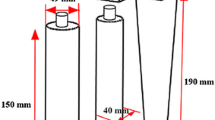Conclusions
-
1.
As the result of reactional diffusion during heating of bimetal A6+190+A6 a layer is formed consisting of the following phases (in sequence from brass to aluminum): α solid solution of aluminum in copper, γ2 phase (Cu9Al4), δ phase (Cu3Al2), and θ phase (CuAl2). The first phase formed is δ phase, θ phase appearing only at higher temperatures. All phases are rich in zinc.
-
2.
The growth rate of each phase and the layer as a whole follows a parabolic rule, but the growth rate varies exponentially with temperature.
Similar content being viewed by others
Literature cited
P. F. Zasukha et al., Rolled Bimetals [in Russian], Metallurgiya, Moscow (1971), p. 87.
V. Z. Bugakov, Diffusion in Metals and Alloys [in Russian], GITTL (1949), p. 142.
Y. Funamizy and K. Watanabe, Trans. Japan. Inst. Metals,12, No. 3, 147 (1971).
Yu. I. Kozlov and V. I. Itin, Poroshk. Metall., No. 6, 20 (1973).
Additional information
Ural Scientific-Research Institute of Ferrous Metals. Translated from Metallovedenie i Termicheskaya Obrabotka Metallov, No. 5, pp. 19–22, May, 1977.
Rights and permissions
About this article
Cite this article
Ershov, A.A., Sycheva, T.A. & Zasukha, P.F. Reactional diffusion in three-layer aluminum-brass bimetal. Met Sci Heat Treat 19, 356–359 (1977). https://doi.org/10.1007/BF00703007
Issue Date:
DOI: https://doi.org/10.1007/BF00703007




